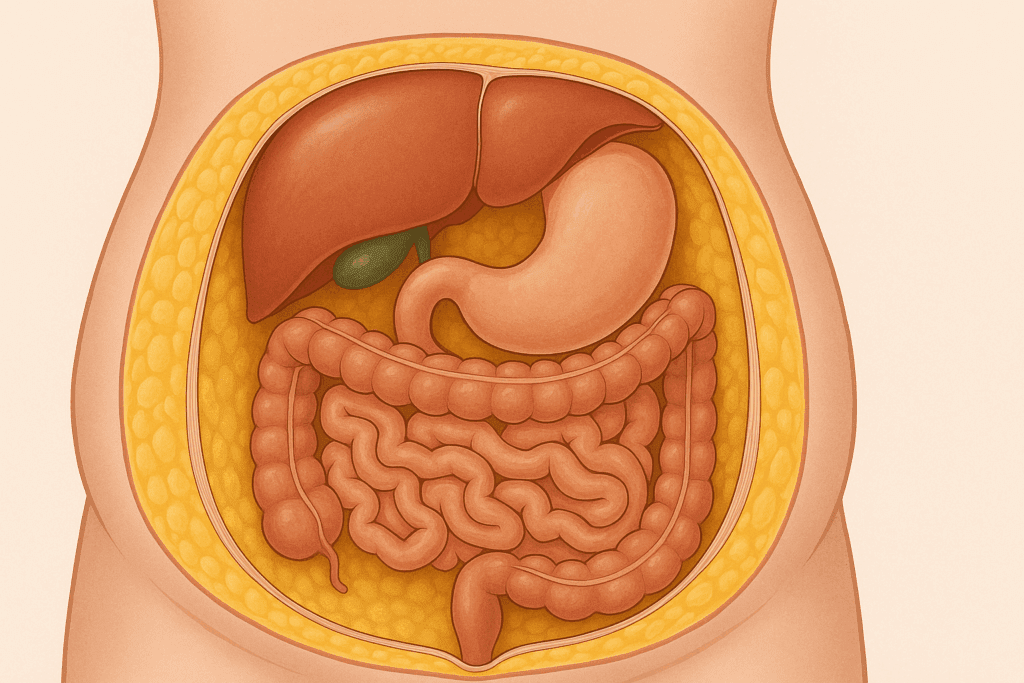Reaching your 40s often brings a profound shift in how your body responds to diet, exercise, and stress. One of the most common and frustrating concerns that individuals face at this stage of life is the development of a hanging belly. Medically referred to as abdominal panniculus, this excess fat and skin accumulation can result from a combination of aging, hormonal shifts, reduced physical activity, and changes in metabolism. Fortunately, there are safe, science-backed strategies to reverse this condition and restore core strength, improve posture, and support long-term wellness. This article explores how to lose a hanging belly safely after 40, providing doctor-recommended ways to get rid of a hanging stomach that prioritize both effectiveness and your overall health.
You may also like: Expert-Backed Weight Loss Tips for a Healthier Lifestyle: What You Need to Know for Long-Term Weight Control and Wellness

Understanding the Causes of a Hanging Belly After 40
As the body ages, a gradual decline in muscle mass, also known as sarcopenia, begins to alter body composition. This muscle loss leads to a decrease in basal metabolic rate, meaning the body burns fewer calories at rest. At the same time, hormonal changes, particularly in women experiencing perimenopause or menopause, contribute to fat redistribution—often resulting in increased visceral fat around the midsection. In men, a decrease in testosterone can lead to a similar pattern of fat accumulation.
Additionally, lifestyle factors such as increased stress, poor sleep quality, and sedentary habits become more pronounced with age and can accelerate weight gain. The result is often a protruding or hanging belly that can feel resistant to traditional weight loss methods. Genetics may also play a role, particularly in how fat is stored in the abdominal area and how the skin responds to weight fluctuations over time. Understanding these physiological changes is essential when developing a plan for how to lose hanging belly fat that is realistic and sustainable.

The Science of Belly Fat: Subcutaneous vs. Visceral Fat
Not all belly fat is created equal. The soft, pinchable fat just beneath the skin—known as subcutaneous fat—can contribute to the look and feel of a hanging stomach, but it is typically less dangerous than visceral fat, which lies deeper within the abdominal cavity and surrounds the organs. Visceral fat has been linked to increased risks of type 2 diabetes, cardiovascular disease, and metabolic syndrome.
As individuals explore how to lose hanging stomach fat, it is important to understand that while reducing subcutaneous fat improves cosmetic appearance, targeting visceral fat carries far greater health benefits. Both types of fat respond to lifestyle changes, but visceral fat tends to be more metabolically active, meaning it responds more readily to exercise and dietary interventions. Focusing on these proven strategies can help you get rid of a hanging belly while also enhancing your internal health.
Why Diet Plays a Central Role in Losing a Hanging Belly
Dietary adjustments form the foundation of any plan focused on how to lose a hanging belly. After age 40, the body becomes more sensitive to the quality and timing of food intake. A diet high in refined carbohydrates, added sugars, and saturated fats tends to encourage fat storage, especially in the midsection. To lose hanging belly fat effectively, nutrition must be aligned with metabolic health.
A Mediterranean-style diet rich in vegetables, fruits, lean proteins, legumes, whole grains, and healthy fats such as olive oil has consistently shown benefits for reducing abdominal fat. Prioritizing anti-inflammatory foods helps regulate blood sugar, reduce insulin resistance, and improve fat metabolism. Furthermore, increasing protein intake to preserve muscle mass is critical when crafting a diet for how to lose belly fat at age 48 and beyond.
Meal timing and portion control also play an essential role. Many experts advocate for time-restricted eating windows, such as intermittent fasting, which may help regulate hunger hormones and improve fat oxidation. While not suitable for everyone, these approaches can be effective when supervised by a medical professional, particularly for those seeking to quickly lose a hanging belly in a healthy and sustainable way.

The Role of Strength Training and Resistance Exercise
While cardio is valuable for burning calories, strength training becomes increasingly important after 40 for preserving lean muscle mass and increasing basal metabolic rate. Exercises that target the core, hips, and lower back help tighten the muscles underlying the abdominal area, improving both appearance and functional strength. Resistance-based workouts not only support fat loss but also help prevent future fat accumulation.
Programs that incorporate compound movements—such as squats, deadlifts, lunges, and planks—are particularly effective. These exercises engage multiple muscle groups simultaneously and elevate post-exercise energy expenditure. For those wondering how to lose a hanging stomach without excessive cardio, integrating resistance training three to four times per week can produce measurable improvements.
Importantly, building strength in the abdominal wall can help reduce the sagging appearance of a hanging belly, especially when combined with fat loss from dietary changes. Although targeted exercises do not eliminate fat from specific areas, they improve muscle tone, posture, and support for internal organs—all of which contribute to reducing the visibility of excess abdominal skin and fat.
Stress Management and Hormonal Balance
Chronic stress is often an underestimated contributor to abdominal fat gain. Elevated cortisol, the body’s primary stress hormone, promotes fat storage around the midsection and can increase appetite for calorie-dense, sugary foods. In individuals over 40, stress-related hormonal imbalances become more pronounced, making it harder to lose belly fat even with a calorie deficit.
Mindfulness practices, such as yoga, meditation, deep breathing, and tai chi, have been shown to reduce cortisol levels and improve emotional regulation. In turn, this can support weight loss efforts and prevent stress-related eating. For individuals actively researching how to lose hanging belly fat, managing stress is not a secondary concern but a central pillar of any effective plan.
Additionally, sleep quality has a direct relationship with hormonal balance and fat regulation. Poor sleep can disrupt leptin and ghrelin levels—hormones that control hunger and satiety—making it more difficult to maintain a calorie deficit. Prioritizing consistent, restorative sleep of at least seven hours per night can enhance your efforts to get rid of a hanging belly by supporting hormonal health and metabolic efficiency.

Medical Evaluations and Hormonal Testing
If traditional methods of diet and exercise do not yield expected results, a medical evaluation may reveal underlying issues that make it more difficult to lose a hanging stomach. Thyroid dysfunction, insulin resistance, and sex hormone imbalances (such as low estrogen, progesterone, or testosterone) are common after 40 and can significantly impact fat distribution and metabolism.
Consulting a healthcare provider for blood tests and a full hormonal panel is an evidence-based step toward understanding your body’s unique needs. For some, bioidentical hormone replacement therapy (BHRT) or targeted supplements may support overall efforts when guided by a trained medical professional. Rather than relying solely on anecdotal strategies, this medically informed approach adds a layer of precision and safety to your journey.
By identifying these hidden barriers, individuals can adopt a more tailored strategy for how to lose belly fat at age 48 or older. In some cases, a multidisciplinary approach involving a dietitian, endocrinologist, and fitness expert may be necessary to achieve and maintain results without frustration or guesswork.
The Importance of Consistency and Realistic Expectations
One of the most common challenges in addressing how to quickly lose a hanging belly is the desire for rapid, dramatic results. However, sustainable fat loss is rarely immediate. Setting realistic goals, celebrating small milestones, and practicing patience are essential to staying motivated over time. Rapid fat loss may seem appealing, but it often leads to muscle loss and can exacerbate skin sagging, especially in those with a history of weight fluctuations.
Instead, adopting a consistent, gradual approach allows the skin and connective tissues time to adjust. In many cases, the appearance of a hanging belly improves significantly within three to six months of adopting a structured plan. This timeline varies based on genetics, prior weight loss history, skin elasticity, and current health status. Nevertheless, the benefits of improved metabolic health, mobility, and self-confidence far outweigh any perceived delay in visual transformation.

Hydration, Skin Elasticity, and Nutrient Support
Another often overlooked factor in how to lose hanging stomach fat involves skin health and hydration. Skin elasticity tends to decline with age due to decreased collagen production, making it harder for the skin to rebound after fat loss. Ensuring adequate hydration, both through water intake and water-rich foods, supports tissue function and elasticity.
Key nutrients such as vitamin C, vitamin E, collagen peptides, and omega-3 fatty acids can also support skin structure. These nutrients contribute to collagen synthesis and reduce oxidative damage that accelerates skin aging. While they are not substitutes for fat loss or exercise, they complement a broader strategy to reduce the appearance of loose or hanging skin during weight loss.
Topical treatments like retinol creams, firming serums, and even non-invasive dermatological procedures such as radiofrequency or ultrasound skin tightening may be beneficial adjuncts. These interventions should always be used under professional guidance but can enhance your efforts when trying to get rid of a hanging belly in a medically appropriate and holistic way.
Why Age 48 Is a Turning Point
There is something uniquely challenging about trying to lose belly fat at age 48. This is often a time of compounded lifestyle demands—career transitions, caregiving responsibilities, and approaching or experiencing menopause. Hormonal fluctuations reach a peak during this stage, often intensifying fat accumulation in the abdominal area.
It is also a pivotal opportunity to adopt long-term strategies that protect against chronic diseases. The benefits of losing a hanging belly at this age go far beyond aesthetics—they include improved cardiovascular health, better blood sugar regulation, reduced joint strain, and greater vitality. Approaching this phase with self-compassion and medical awareness allows for better adherence and reduced frustration.
By integrating doctor-recommended nutritional strategies, exercise routines, stress reduction practices, and, when necessary, medical intervention, individuals at this age can reclaim control over their health trajectory. A hanging belly may be a signal to shift priorities, but it is never a sentence. Sustainable change remains entirely possible with the right tools and mindset.

The Psychological Impact and Body Image Considerations
The emotional burden of a hanging stomach should not be underestimated. Many individuals report decreased self-esteem, social withdrawal, or even depression linked to body image concerns. This is especially true for women, who often face cultural pressures regarding appearance, or for individuals who have recently lost a significant amount of weight only to be left with lingering skin folds.
Addressing how to lose hanging stomach fat must therefore include psychological support. Working with a licensed therapist or counselor can provide coping strategies, body neutrality practices, and tools to rebuild confidence. Support groups and online communities can also be valuable spaces for shared experiences and encouragement.
Combining physical health improvements with emotional resilience creates a more sustainable and empowering journey. Feeling good about your progress—and not just how your stomach looks in the mirror—fosters better adherence to healthy habits and reinforces long-term lifestyle changes. Mind and body health are inseparable, particularly when trying to lose a hanging belly after 40.
Frequently Asked Questions (FAQ): How to Lose a Hanging Belly Safely After 40
1. Can specific breathing techniques help reduce a hanging belly?
Yes, certain breathing techniques, such as diaphragmatic breathing and hypopressive exercises, can support core activation and improve abdominal wall tone. These methods work by engaging the deep transverse abdominis, which acts like a natural corset for the midsection. While they do not directly burn fat, they can help retrain posture and reduce the visible protrusion often associated with a hanging belly. Incorporating these techniques alongside your main strategy for how to lose hanging belly fat can yield better structural and aesthetic results. This is particularly beneficial for those over 40 who may have reduced muscle tone due to aging or post-pregnancy changes.
2. Are there differences in how men and women should approach losing a hanging belly after 40?
Yes, gender differences in hormones and fat distribution mean that the strategies for how to get rid of a hanging belly often vary between men and women. Women in perimenopause or menopause may need to focus more on estrogen-supportive nutrition and stress reduction, while men might respond better to testosterone-supportive strength training and higher protein intake. Additionally, women tend to store more subcutaneous fat, while men are more prone to visceral fat, influencing the visual appearance of a hanging stomach. Recognizing these physiological differences helps tailor more effective methods when learning how to lose hanging belly or address stubborn fat around the midsection.
3. How does alcohol consumption affect efforts to lose hanging stomach fat?
Alcohol can significantly hinder fat loss, particularly when targeting how to lose hanging stomach fat. It interferes with liver metabolism, promotes fat storage, and reduces testosterone levels—especially problematic for men trying to reduce abdominal fat. Moreover, alcohol often leads to increased calorie intake through poor food choices and disrupted sleep, which negatively affects hormone regulation. For anyone trying to lose belly fat at age 48 or older, reducing alcohol intake can make a measurable difference. Even small reductions in weekly consumption can improve results over time and support long-term belly fat reduction.
4. Is it possible to tighten loose skin after fat loss without surgery?
Non-surgical methods such as collagen supplementation, strength training, infrared therapy, and radiofrequency treatments can improve skin elasticity over time. While they may not completely reverse significant sagging, especially after major weight loss, they do support gradual skin tightening. For individuals actively researching how to lose hanging belly fat, these techniques can complement fat loss efforts by improving skin resilience and tone. Consistent hydration, nutrient-rich foods, and avoiding smoking also enhance your skin’s ability to rebound. While not a substitute for surgery in extreme cases, these methods provide valuable non-invasive options.
5. What role does intermittent fasting play in losing a hanging stomach after 40?
Intermittent fasting has gained popularity for its effects on insulin sensitivity and fat metabolism. When done safely and with medical supervision, it can be a useful tool in strategies for how to lose hanging belly, especially for those who struggle with late-night eating or snacking. By narrowing your eating window, the body has more time to shift into fat-burning mode, particularly helpful for visceral and subcutaneous fat loss. It may also reduce inflammation, which can further support efforts to lose belly fat at age 48. However, it’s crucial to pair fasting with nutrient-dense meals to avoid muscle loss and nutrient deficiencies.
6. Can gut health influence belly fat and bloating that mimic a hanging stomach?
Absolutely. Poor gut health can cause bloating, water retention, and inflammation that exaggerate the appearance of a hanging stomach. Conditions such as dysbiosis or irritable bowel syndrome (IBS) may also contribute to a distended belly even in individuals without high levels of body fat. Probiotic-rich foods, prebiotics, and fiber can improve gut health and aid digestion, which in turn can make the stomach appear flatter and firmer. For those looking into how to lose hanging belly fat, addressing gut health can be a surprisingly impactful strategy. In some cases, working with a dietitian specializing in gastrointestinal health is recommended.
7. How do weight loss plateaus affect efforts to lose a hanging belly, and how can they be overcome?
Weight loss plateaus are common and can be particularly frustrating when trying to lose hanging stomach fat. They often occur due to metabolic adaptation, hormonal shifts, or muscle loss. Breaking through a plateau may require varying your exercise routine, increasing protein intake, or adjusting caloric intake to reflect current metabolic needs. Sometimes, even slight changes—like increasing daily steps or modifying workout intensity—can reignite progress. Persistence and flexibility are essential when learning how to lose belly fat at age 48 or later, especially as the body becomes more resistant to change.
8. Can body posture make a hanging belly appear worse than it actually is?
Yes, poor posture—especially anterior pelvic tilt and forward head posture—can push the abdomen outward and make a hanging belly appear more pronounced. Strengthening the core, glutes, and back muscles can help realign posture and reduce this visual effect. Posture-focused exercises like yoga, Pilates, and targeted mobility work can complement your main plan for how to get rid of a hanging belly. Over time, these improvements not only aid appearance but also reduce back pain and improve functional movement. Correcting posture is an often-overlooked but powerful way to enhance the results of belly-focused fitness programs.
9. How do social and emotional factors impact the ability to lose hanging belly fat?
Emotional stress, body image issues, and social pressures can all influence how someone approaches fat loss and self-care. These factors may lead to emotional eating, avoidance of physical activity, or inconsistent habits. Individuals trying to figure out how to quickly lose a hanging belly often benefit from psychological support, whether through counseling, support groups, or mindfulness practices. Addressing emotional well-being is just as important as physical health in a successful fat loss journey. Building a strong support system can improve consistency, confidence, and long-term outcomes.
10. What are the latest innovations in medical technology for reducing a hanging stomach?
New medical technologies now offer non-invasive or minimally invasive options for reducing abdominal fat and tightening skin. Treatments like cryolipolysis (CoolSculpting), high-intensity focused ultrasound (HIFU), and laser-assisted lipolysis are being used with increasing success. These are not replacements for lifestyle changes, but they may provide additional support when conventional strategies plateau. For those curious about how to lose hanging belly without surgery, consulting with a board-certified dermatologist or aesthetic medicine physician can reveal options that fit their goals. These innovations expand the toolkit for losing hanging belly fat in a way that aligns with safety, comfort, and real-world expectations.
Conclusion: A Holistic, Medically-Informed Approach to Losing a Hanging Belly After 40
The path to losing a hanging belly safely after 40 involves more than quick fixes or cosmetic concerns. It requires a holistic approach that honors the body’s physiological changes, prioritizes evidence-based practices, and supports both physical and emotional well-being. Whether you’re exploring how to lose hanging belly fat, how to lose belly fat at age 48, or how to quickly lose a hanging belly, the key is to blend sustainable nutrition, resistance training, hormone management, and mental health care.
Getting rid of a hanging belly is not just about fitting into smaller clothes—it’s about improving metabolic health, reducing disease risk, and increasing daily comfort and confidence. Doctor-recommended strategies emphasize gradual progress, consistency, and compassion toward your changing body. By respecting the body’s evolving needs and implementing expert-guided practices, it is entirely possible to lose hanging stomach fat and maintain the results with long-term success.
As you move forward, remember that your body deserves care, not criticism. Each step you take toward improving your health is a victory worth celebrating. With the right support, knowledge, and strategy, you can transform your approach to wellness, reclaim your core strength, and feel empowered in your body once more.
Was this article helpful? Don’t let it stop with you. Share it right now with someone who needs to see it—whether it’s a friend, a colleague, or your whole network. And if staying ahead on this topic matters to you, subscribe to this publication for the most up-to-date information. You’ll get the latest insights delivered straight to you—no searching, no missing out.


